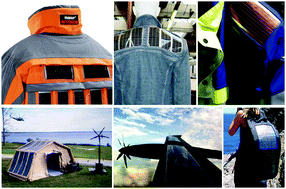Recent progress in flexible–wearable solar cells for self-powered electronic devices†
Abstract
Photovoltaic devices have become ideal alternatives to common energy sources due to their excellent mechanical robustness and high power conversion efficiency, which can meet the human requirements for green, inexpensive and portable electricity sources. Moreover, due to the rapid development of wearable devices, telecommunication, transportation, advanced sensors, etc., the need for green and accessible power sources for these state-of-the-art devices accompanied with appropriate mechanical stability has become a new challenge. In this regard, flexible–wearable photovoltaic platforms can be easily adapted to any device/substrate and can supply diverse electronic devices with their required energy via harvesting energy from sunlight. Similarly, photovoltaic platforms can be integrated into hybrid platforms and can be used in diverse applications. Herein, we summarize the recent approaches to developing flexible–wearable solar cells as energy sources for supplying self-powered wearable devices. In this regard, first, recent advances in transparent flexible electrodes and their diversities are reported; then, recently developed flexible solar cells and important factors for designing these platforms are summarized. Further, flexible solar cells are categorized into five different sections (i.e., perovskite, dye-sensitized, organic, fiber-shaped and textile solar cells) and their mechanisms, working principles and design criteria along with their recent advances have been discussed. Finally, novel applications of wearable sensors/devices are summarized and reported to highlight the functionality of these practical platforms.



 Please wait while we load your content...
Please wait while we load your content...